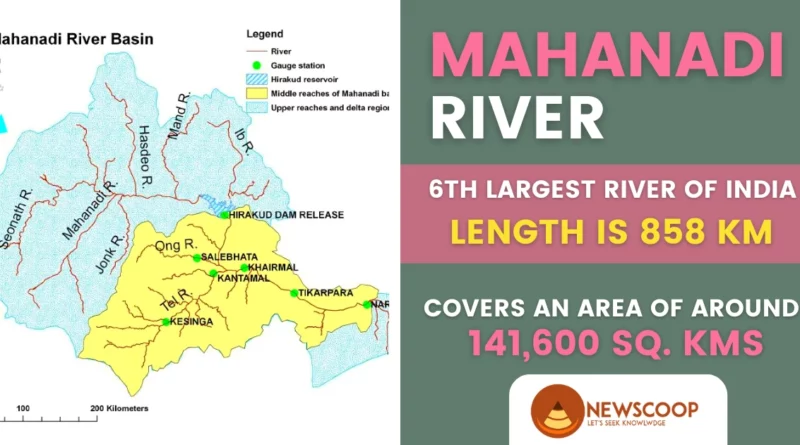Mahanadi River: Map & Dams | Left & Right Bank Tributaries
The Mahanadi River has been an important water source for the people of Odisha for centuries. The river has been mentioned in the Ramayana and the Mahabharata. The river was also mentioned in the writings of Chinese traveler Hieun Tsang, who visited Odisha in the 7th century AD. The river was an important trade route during the medieval period, with ships carrying goods from Odisha to Southeast Asia.
Mahanadi River is one of the major rivers of India, flowing through the eastern state of Odisha. It is the sixth-largest river in India and has a length of 858 km. The river originates from the hills of Chhattisgarh and flows through Odisha before draining into the Bay of Bengal. The river is an important source of water for irrigation, drinking, and industrial purposes in the state of Odisha.
In this article, we will discuss the history, geography, tributaries, dams, economy, and ecology of the Mahanadi River.
| Fact | Information |
|---|---|
| Length | 858 km |
| Origin | Sihawa in the Dhamtari district, Chhattisgarh |
| Basin Area | 141,600 sq. km |
| Percentage | Chhattisgarh: 54% |
| Odisha: 46% | |
| Tributaries | Seonath, Jonk, Mand, Ib, Ong, Tel, Brahmani |
| Dams | Hirakud Dam (one of the largest dams in India) |
| Mouth | Bay of Bengal, near Paradip |
| Wetlands | Includes Chilika Lake, the largest brackish water lake in Asia |
Geographical Features of the Mahanadi River
Here are some key geographical features of the Mahanadi River:
- Length: The Mahanadi River is 858 km long, making it the sixth-largest river in India.
- Origin: The river originates from the hills of Chhattisgarh, near the town of Sihawa in the Dhamtari district.
- Basin: The Mahanadi River basin covers an area of 141,600 sq. km, of which 54% lies in Chhattisgarh and the remaining 46% in Odisha.
- Tributaries: The river has several tributaries such as the Seonath, Jonk, Mand, Ib, Ong, Tel, and Brahmani.
- Dams and Reservoirs: The river basin has several dams, reservoirs, and barrages, including the Hirakud Dam, one of the largest dams in India.
- Mouth: The Mahanadi River meets the Bay of Bengal near the port city of Paradip.
- Topography: The river flows through the districts of Raipur, Mahasamund, Dhenkanal, Cuttack, Jajpur, and Kendrapara in Odisha, and has a diverse topography, ranging from the hills of Chhattisgarh to the coastal plains of Odisha.
- Wetlands: The Mahanadi River basin has several wetlands, including the Chilika Lake, which is the largest brackish water lake in Asia, and a Ramsar site.
- Flora and Fauna: The river and its tributaries are home to a diverse range of flora and fauna, including several fish and bird species, as well as reptiles and mammals such as crocodiles and otters.
- Ecological Importance: The Mahanadi River basin is an important ecological hotspot, supporting rich biodiversity and providing several ecosystem services, including water supply, fishery resources, and flood regulation.
Map of Mahanadi River

Left & Right Bank Tributaries of Mahanadi River
The Mahanadi River has several left and right bank tributaries that contribute to its flow and support the ecology of the river basin. Here are some of the key tributaries of the Mahanadi River:
Left Bank Tributaries of Mahanadi
- Seonath: The Seonath River is a left-bank tributary of the Mahanadi River that originates in the Maikal Hills in Chhattisgarh. It joins the Mahanadi near the town of Rajim in the Gariaband district.
- Jonk: The Jonk River is a left-bank tributary that originates in the Raipur district of Chhattisgarh. It joins the Mahanadi near the town of Sambalpur in Odisha.
- Mand: The Mand River is a left-bank tributary that originates in the Dhamtari district of Chhattisgarh. It joins the Mahanadi near the town of Naraj in Odisha.
- Ib: The Ib River is a left-bank tributary of the Mahanadi River that originates in the Raigarh district of Chhattisgarh. It joins the Mahanadi near the town of Sonepur in Odisha.
Right Bank Tributaries of Mahanadi
- Ong: The Ong River is a right-bank tributary of the Mahanadi River that originates in the Raigarh district of Chhattisgarh. It joins the Mahanadi near the town of Boudh in Odisha.
- Tel: The Tel River is a right-bank tributary of the Mahanadi River that originates in the Balangir district of Odisha. It joins the Mahanadi near the town of Sonepur in Odisha.
- Brahmani: The Brahmani River is a right-bank tributary of the Mahanadi River that originates in the Sundargarh district of Odisha. It joins the Mahanadi near the town of Rengali in Odisha.
These tributaries play an important role in regulating the flow of the Mahanadi River and supporting the ecology of the river basin. They also provide a source of water for irrigation, domestic use, and industry in the region. However, the increasing demand for water and the effects of climate change are putting pressure on these tributaries and the Mahanadi River, highlighting the need for sustainable water management practices in the region.
Dams on the Mahanadi River
The Mahanadi River basin has several dams, barrages, and reservoirs, which are used for various purposes, such as irrigation, hydroelectric power generation, and flood control. Here are some of the major dams on the Mahanadi River:
1. Hirakud Dam
- The Hirakud Dam is one of the largest dams in India, located on the Mahanadi River in Odisha.
- It was built in 1953 and serves multiple purposes such as flood control, irrigation, and power generation.
- The dam is 4.8 km long and has a maximum height of 60 meters.
- The Hirakud Reservoir, formed by the dam, is the largest artificial lake in Asia and also serves as a major tourist attraction.
2. Rengali Dam
- The Rengali Dam is a multipurpose dam located on the Brahmani River, which is a right-bank tributary of the Mahanadi River.
- The dam was built in 19ose of irrigation and power generation.
- The reservoir created by the dam also serves as a source of water supply for the nearby towns and villages.
3. Sondhi Dam
- The Sondhi Dam is a small dam located on the Mahanadi River in Chhattisgarh.
- It was built in 1972 for irrigation and water supply.
- The reservoir created by the dam is also used for fishing and boating.
4. Mandira Dam
- The Mandira Dam is a multipurpose dam located on the Ib River, which is a left-bank tributary of the Mahanadi River.
- The dam was built in 1957 for the purpose of irrigation, power generation, and flood control.
- The reservoir created by the dam is also used for fishing and boating.
These dams and reservoirs have played an important role in the development of the region, providing water for irrigation, power generation, and other purposes.
However, their construction and operation have also had significant environmental and social impacts, including the displacement of local communities and the alteration of the river’s natural flow. It is important to ensure that the construction and operation of such infrastructure are done in a sustainable and equitable manner, taking into account the needs and concerns of all stakeholders.
Ecology
The Mahanadi River basin is home to a rich biodiversity. The river and its tributaries are home to a large number of fish species, including several endangered species such as the Ganges River Dolphin and the Mahseer.
The river basin is also home to a large number of bird species such as the Indian Skimmer, the Black-necked Stork, and the Pallas’ Fish Eagle. The river basin also supports a large number of wetlands, which are important breeding and feeding grounds for several bird species.
What are the Challenges?
The Mahanadi River faces several challenges, including pollution, deforestation, and climate change. Industrial effluents and untreated sewage are major sources of pollution in the river.
Deforestation in the river basin has led to soil erosion and siltation, which affects the flow of the river. Climate change is also a major threat to the river, as it leads to erratic rainfall patterns and affects the availability of water in the river.
Conclusion
The Mahanadi River is a vital resource for the state of Odisha. The river has played an important role in the history, economy, and ecology of the state. However, the river faces several challenges, which need to be addressed in a comprehensive manner. The government, civil society, and other stakeholders need to work together to ensure the sustainable use of the river and its resources.
This will not only benefit the people of Odisha but also ensure the conservation of the river’s rich biodiversity for future generations. Steps such as proper waste management, afforestation, and sustainable agriculture practices can go a long way in ensuring the health of the river. Additionally, there needs to be a focus on improving the management of dams and reservoirs to ensure that they are used in a sustainable and equitable manner.
In conclusion, the Mahanadi River is a vital resource for the people of Odisha and its rich history, ecology, and economy make it an important part of India’s natural heritage. However, the challenges faced by the river require a concerted effort from all stakeholders to ensure its long-term sustainability. Through proper management and conservation practices, the Mahanadi River can continue to be a source of life and livelihood for generations to come.
Thank You!
FAQs
What is the length of the Mahanadi River?
The Mahanadi River stretches for a length of 858 kilometers, making it one of the longest rivers in India.
Where does the Mahanadi River originate?
The Mahanadi River originates from the hills of Chhattisgarh, specifically in the Dhamtari district near the town of Sihawa. It emerges as a small stream and gradually gains volume and strength as it flows downstream.
Name some major tributaries of the Mahanadi River.
Some major tributaries of the Mahanadi River include Seonath, Jonk, Mand, Ib, Ong, Tel, and Brahmani.
Related Links:

